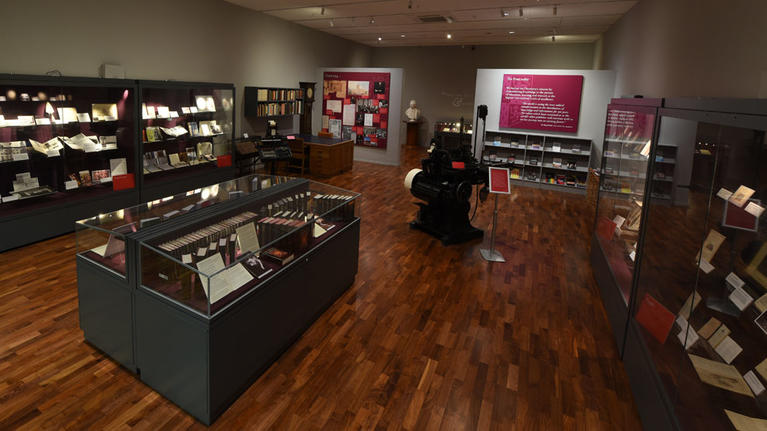The greatest treasure in the library
An exhibition ran in the Press Museum from October 2014 to February 2015, which told the story of Sir Ernest Shackleton and the Press edition of the Encyclopaedia Britannica.

100 years ago, Sir Ernest Shackleton took two sets of the Eleventh Edition Encyclopaedia Britannica published by Cambridge University Press on his expedition to cross the Antarctic continent. When disaster struck the expedition ships Endurance and Aurora, words and paper helped the survival, both mental and physical, of explorers on the Imperial Trans-Antarctic Expedition.
Published in 1910-11, these volumes could fill hours, expand horizons and settle any argument. 40,000 articles could inform, educate, delight and engage. Words were vital for survival so volumes and torn-out pages were saved when so much else was abandoned to the ice.
Meredith Hooper, Visiting Fellow of Wolfson College Cambridge, curated this exhibition. She calls the Encyclopaedia Britannica the ‘internet before the internet’. Her archival research reveals for the first time the names of benefactors who gave the volumes to the expedition, and identifies the volumes which survived tough decisions about what to keep, what to destroy. She writes, ‘The pristine volumes that sank in the Weddell Sea, the well-used blubber-impregnated volumes abandoned on floes, the pages burnt as fire-lighters, or wrapping the comfort of addictive tobacco substitutes, the remnants left behind in the hut contrived by balancing the two remaining boats, upturned, on low stone walls on Elephant Island. Ocean-drowned, or ice-buried, the Eleventh Edition of the Encyclopaedia Britannica was in truth a trusty guide and, most precisely, as the editors had confidently claimed, to ‘all class of readers’. *

With the aroma of seal-blubber stoves still lingering and paper blackened by sooty fingers turning pages, two volumes of the Encyclopaedia Britannica, borrowed from the Royal Geographical Society, are testimony to the lesser-known men of Shackleton’s expedition. Based in the Ross Sea area, they would lay supply depots towards the Pole for the explorers hauling their sledges across the ice. Marooned ashore when their ship drifted north, ten men endured the extremities of polar winter, sustained by the power of words to engage their minds.
Along with volumes loaned from the Royal Geographical Society, London, we are privileged to show an original diary written by expedition physicist R.W. James from The Scott Polar Research Institute, University of Cambridge. Evocative images by expedition photographer, Frank Hurley, bring the explorers’ lives into sharp focus.
* Quoted with kind permission of Meredith Hooper and Stephen Scott-Fawcett, editor of the James Caird Society Journal.
The Press museum
The rich history of Cambridge University Press is preserved in the Press Archive held at Cambridge University Library.
A selection of items is also on display at our Shaftesbury Road site in Cambridge.


